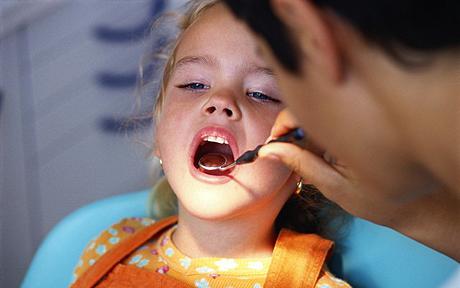 Children’s first baby tooth would erupt at the age of 5-6 months. Some babies differ by six months to a year and it is normal. There are some dental problems in toddlers which many of us should take note for a developing child.
Children’s first baby tooth would erupt at the age of 5-6 months. Some babies differ by six months to a year and it is normal. There are some dental problems in toddlers which many of us should take note for a developing child.
Baby Bottle Caries (Early Childhood Caries)
This is characterized by brown or black decays on the front surfaces of baby teeth especially the upper anteriors. This occurs because when baby is fed, residual milk or sweetened liquid are trapped between inner surface of upper lip and the front surfaces of upper teeth. This causes intense plaque build up leading to tooth decay. It is worsened when the child is fed before sleep without brushing. A prolonged exposure to plaque increases risk for tooth decay. This also applies to babies being breast fed before sleep. You may find that lower anterior baby teeth are usually very healthy as they are often exposed to saliva which could help wash away plaque.
Prevention
If possible do not feed the child close to sleeping time. If it is inevitable, brush their teeth before they go to bed or allow them to drink only plain water before bedtime. Gargling with plain water after feeding also helps but brushing is the best. For children who are too young to hold a toothbrush you can wipe the surfaces of the teeth with a clean cloth or you can carefully brush them without toothpaste.
Mal-aligned Or Crooked Teeth Due To Habit
Â
Babies like to put things inside their mouth to explore the things around them. If they continue this habit into an older age they might develop the habit of biting fingernails, pencils or other objects they can get a hold onto. Sometimes, they like to suck their thumbs as well. This habit would cause growing teeth to get mal-aligned. This happens mostly on upper and lower anterior teeth where there is an abnormal spacing in between the teeth that simulates the shape of the object they bite. Most of the times, the children may have anterior open bites which show that they could not bite teeth to teeth in the anterior aspect. When teeth are mal-aligned they are difficult to maintain thus having tooth decay problems.
Prevention
To prevent mal-alignment simply stop the habit. Sometimes the teeth would reposition themselves once habit is removed as other growing teeth may aid in correct repositioning. Otherwise mal-aligned teeth would not move but the condition would not worsen either. Just make sure that they do not practice the same habit when permanent teeth are growing.
Tooth Discoloration
Tooth discoloration can happen for various reasons.
Fluorosis
Excessive intake of fluoride through drinking water or accidental ingestion of fluoride toothpaste may cause this. Tooth surface may have irregular white spots or flakes.
Inadequate brushing
Plaque building up on teeth surfaces may cause them looking yellowish. In severe cases they will appear brownish or blackish when there’s decay.
Medications
Infant medication with iron may stain the teeth to blackish appearance. Pregnant mum taking tetracycline would also cause tetracycline staining in infant’s teeth. They would have a brownish blackish hue.
Trauma
Accidental falls or hits may cause trauma to anterior milk teeth. They would look reddish black as they may be non vital after the accident. Usually an abscess would follow.
Illness or medical problem during infancy
High fever or certain severe medical conditions may affect the normal development of baby teeth while they are still in the gums. These teeth may appear yellowish, brownish or malformed.
Prevention
Parents should keep an eye on children teeth always. Bottle feeding should cease once the child is able to drink with cup. Pacifiers are not encouraged after the age of three. Fluoridated toothpaste is not advised for children who do not know how to spit. If you notice something wrong with your child’s teeth please consult a dentist as soon as possible.
Abscess and Facial Swelling
Abscess of a tooth is usually associated with an untreated tooth decay that has gone down to the pulp region. Gum and facial swelling are common among kids with rampant caries. This usually happens to baby molars (furthest back teeth) and incisors (front teeth). Usually dentist would prescribe antibiotics and pain killers to arrest the signs and symptoms. Subsequently, root canal therapy for baby teeth or extraction could be carried out to solve the problem.
Prevention
Bring your child for a routine dental check up every six months. Try to treat decays as soon as possible even your child may not fancy going to the dentist. Dental education since young is really important.
Hand Foot and Mouth Disease
This is a viral infection that may cause fever, loss of appetite, headache, blisters in hands, feet and diaper areas, ulcers in throat, mouth and tongue. This usually happens to children under age of 10. It could be transmitted through infected nasal and oral discharges, human contact and fluid from ruptured blisters. No medication is required for this disease as it would heal by itself within 5 to 7 days. Medicines are only given to treat fever and pain. Cold drinks like yogurt or chilled milk are advisable so that children would not be dehydrated. Urgent medical attention is required should your child suffer from convulsion if fever does not subside.
Prevention
Wash hands regularly and keep a hygienic environment for your kids. Advise them not to suck their fingers often. Do not share toothbrushes or towels between siblings.
Conclusion
All toddlers’ dental problems are easily dealt with should we settle things early. Prevention is always better than cure.
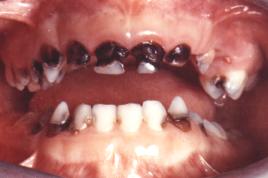
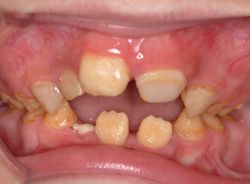
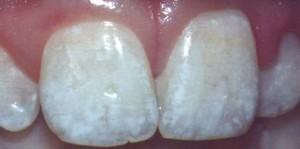
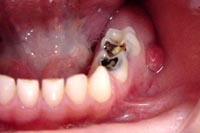
Wow! I am feeling better about my 3 year old’s teeth! He injured several of his top teeth and just had one of them extracted. But at least what’s left looks better than these poor kiddos. I’ve found some helpful info on caring for my kids’ teeth on this Mom’s Guide, if you want to check it out.